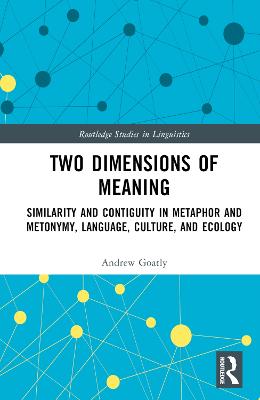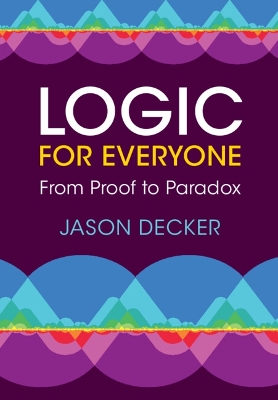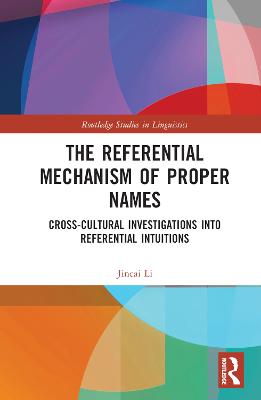Two Dimensions of Meaning
 portes grátis
portes grátis
Two Dimensions of Meaning
Similarity and Contiguity in Metaphor and Metonymy, Language, Culture, and Ecology
Goatly, Andrew
Taylor & Francis Ltd
09/2022
386
Dura
Inglês
9781032258089
15 a 20 dias
453
Descrição não disponível.
0. Introduction: the similarity/contiguity distinction and an outline of the book.
1. The two dimensions: similarity and contiguity in metaphor and metonymy
2. The prevalence of metaphor and metonymy and their interplay
3. The Development of Language in two Dimensions of Meaning.
4. Corpus linguistics, collocation and lexical priming
5. The syntagmatic contiguity of metonymy in grammar and narrative.
6. Nouns and noun phrases: the similarity dimension, classification, quantification and commodification.
7. Nouns and the similarity mode: classification, taxonomies, paradigms and measurement in science and mathematics.
8. Resisting noun-based classification and scientific universals in sociology, linguistics, philosophy and poetry
9. Process and interrelatedness in quantum physics and Blackfoot, a language without nouns.
10. Feyerabend and Conquest of abundance: abstraction versus the richness of being
11. Conclusion (1): Evaluating the two dimensions
12. Conclusion (2): interplay, synthesis, and the need for diverse metaphors
Appendix1. Metaphor themes associated with the canonical event schema: CHANGE IS MOVEMENT, ACTIVITY IS MOVEMENT FORWARDS etc.
Appendix 2. Lexical details of the EMOTION IS SENSE IMPRESSION nexus.
1. The two dimensions: similarity and contiguity in metaphor and metonymy
2. The prevalence of metaphor and metonymy and their interplay
3. The Development of Language in two Dimensions of Meaning.
4. Corpus linguistics, collocation and lexical priming
5. The syntagmatic contiguity of metonymy in grammar and narrative.
6. Nouns and noun phrases: the similarity dimension, classification, quantification and commodification.
7. Nouns and the similarity mode: classification, taxonomies, paradigms and measurement in science and mathematics.
8. Resisting noun-based classification and scientific universals in sociology, linguistics, philosophy and poetry
9. Process and interrelatedness in quantum physics and Blackfoot, a language without nouns.
10. Feyerabend and Conquest of abundance: abstraction versus the richness of being
11. Conclusion (1): Evaluating the two dimensions
12. Conclusion (2): interplay, synthesis, and the need for diverse metaphors
Appendix1. Metaphor themes associated with the canonical event schema: CHANGE IS MOVEMENT, ACTIVITY IS MOVEMENT FORWARDS etc.
Appendix 2. Lexical details of the EMOTION IS SENSE IMPRESSION nexus.
Este título pertence ao(s) assunto(s) indicados(s). Para ver outros títulos clique no assunto desejado.
Action Genres;Contiguity Dimensions;Syntagmatic Axis;Noun Phrase;Metonymic Meaning;Vice Versa;English Grammar;Gaia Theory;Grammatical Metaphor;Noun Referents;Young Man;Contiguity Relations;Material Process Clause;Idealised Cognitive Models;Clock Time;Systemic Functional Linguistics;Timeless;Critical Metaphor Analysis;Anthropic Principle;Textual Contiguity;Dense;Macmillan English Dictionary;Formulaic Sequences;Hypotactic Clauses;Lexical Priming
0. Introduction: the similarity/contiguity distinction and an outline of the book.
1. The two dimensions: similarity and contiguity in metaphor and metonymy
2. The prevalence of metaphor and metonymy and their interplay
3. The Development of Language in two Dimensions of Meaning.
4. Corpus linguistics, collocation and lexical priming
5. The syntagmatic contiguity of metonymy in grammar and narrative.
6. Nouns and noun phrases: the similarity dimension, classification, quantification and commodification.
7. Nouns and the similarity mode: classification, taxonomies, paradigms and measurement in science and mathematics.
8. Resisting noun-based classification and scientific universals in sociology, linguistics, philosophy and poetry
9. Process and interrelatedness in quantum physics and Blackfoot, a language without nouns.
10. Feyerabend and Conquest of abundance: abstraction versus the richness of being
11. Conclusion (1): Evaluating the two dimensions
12. Conclusion (2): interplay, synthesis, and the need for diverse metaphors
Appendix1. Metaphor themes associated with the canonical event schema: CHANGE IS MOVEMENT, ACTIVITY IS MOVEMENT FORWARDS etc.
Appendix 2. Lexical details of the EMOTION IS SENSE IMPRESSION nexus.
1. The two dimensions: similarity and contiguity in metaphor and metonymy
2. The prevalence of metaphor and metonymy and their interplay
3. The Development of Language in two Dimensions of Meaning.
4. Corpus linguistics, collocation and lexical priming
5. The syntagmatic contiguity of metonymy in grammar and narrative.
6. Nouns and noun phrases: the similarity dimension, classification, quantification and commodification.
7. Nouns and the similarity mode: classification, taxonomies, paradigms and measurement in science and mathematics.
8. Resisting noun-based classification and scientific universals in sociology, linguistics, philosophy and poetry
9. Process and interrelatedness in quantum physics and Blackfoot, a language without nouns.
10. Feyerabend and Conquest of abundance: abstraction versus the richness of being
11. Conclusion (1): Evaluating the two dimensions
12. Conclusion (2): interplay, synthesis, and the need for diverse metaphors
Appendix1. Metaphor themes associated with the canonical event schema: CHANGE IS MOVEMENT, ACTIVITY IS MOVEMENT FORWARDS etc.
Appendix 2. Lexical details of the EMOTION IS SENSE IMPRESSION nexus.
Este título pertence ao(s) assunto(s) indicados(s). Para ver outros títulos clique no assunto desejado.
Action Genres;Contiguity Dimensions;Syntagmatic Axis;Noun Phrase;Metonymic Meaning;Vice Versa;English Grammar;Gaia Theory;Grammatical Metaphor;Noun Referents;Young Man;Contiguity Relations;Material Process Clause;Idealised Cognitive Models;Clock Time;Systemic Functional Linguistics;Timeless;Critical Metaphor Analysis;Anthropic Principle;Textual Contiguity;Dense;Macmillan English Dictionary;Formulaic Sequences;Hypotactic Clauses;Lexical Priming







